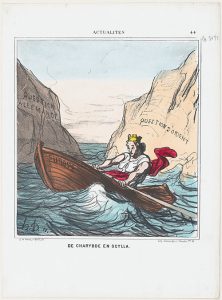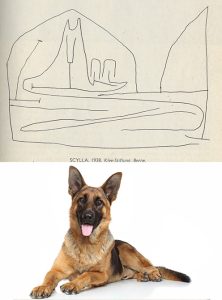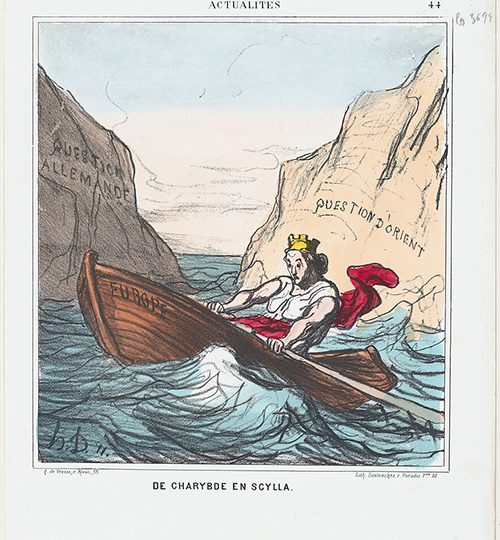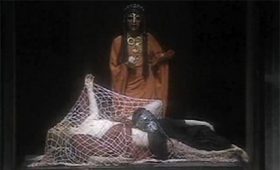Honoré Daumier’s satirical cartoon “De Charybde en Scylla” (From Charybdis to Scylla) is cataloged in the Oxford Guide to Classical Mythology in the Arts as a usage of the myth of Odysseus with Scylla and Charybdis. The usage, however, has more to do with Scylla and less to do with Odysseus. I recommend, therefore, that the image be cataloged with usages of “Scylla Crataeis”.
In a dingy named “Europe” a regal female (Marianne with mural crown?) rows frantically across a rough strait. She must navigate the strait between one cliff (Question Allemande) to another opposite (Question d’Orient). France has a choice between alliances with Germany or with the Ottoman Empire.
(Question d’Orient). France has a choice between alliances with Germany or with the Ottoman Empire.
Dated 20 March 1869, Daumier’s image forewarns of war between France and Germany (the Franco-Prussian War), which actually broke out in the next year.
Daumier’s image of Scylla reduces her to a geological element (no longer a mythological personage), as many others have done. Daumier’s figure of France, Marianne the rower, seems not to be projected here into the role of Odysseus. Rather, it seems Daumier’s seafarer here is more generically conceived and that the myth of Scylla the daughter of Crateis is more fully invoked in this cartoon.

Another similar usage of Scylla Crataeis — i.e. a foreboding obstacle in a frightening sea — is Paul Klee’s “Scylla” (1938). To my eye, Klee depicts a foreboding seascape that features the same current-laden waterway in the foreground and a pair of cliffs that flank a narrow passage that could lead into the open sea beyond. Safe passage is possible, but only through the fractional opening in the prospect ahead. Klee’s conception of the mythological Scylla links the geological obstruction to the canine aspect of the sea-bitch that daunts seafarers.
Klee’s biographer illustrates his chapter of the artist’s “last days” with this drawing. It seems to reflect Klee’s increasing despondency that overcame him in the onset of the illness that would eventually take his life at age 61. The beetling menace of Scylla threatens the artist’s safe passage to the open sea that lies beyond.
I present these two usages of the geological Scylla because in the OGCMA one occurs in the listing of the Glaucus myth, while the other is listed among usages of the Odysseus myth. A more sensible presentation would allow for the two thematically similar usages of Scylla to be discoverable in an article on Scylla herself.
http://ogcma.byu.edu/ScyllaCrataeis2.0011_Klee.htm
http://ogcma.byu.edu/ScyllaCrataeis2.0035_Daumier.htm
________
Honoré Daumier, 1808-1879. “De Charybde en Scylla” (From Charybdis to Scylla). Satirical lithograph. Published in Le Charivari “Actualites”, 20 March 1869.
Delteil, Loys. 1906-30. Le Peintre-graveur Illustré. 32 volumes. 29:3699 with illustration.
The Lilly Jacobson Collection of Daumier prints at the University of North Dakota — https://commons.und.edu/uac-all/202/ [accessed 30 Apr 2024]
Paul Klee, 1879-1940. “Scylla”. Abstract drawing. 1938. Klee Foundation, Bern.
San Lazzaro, Gualtieri di. 1957. Klee: a study of his life and work. Translated by Stuart Hood. New York: Prager.



